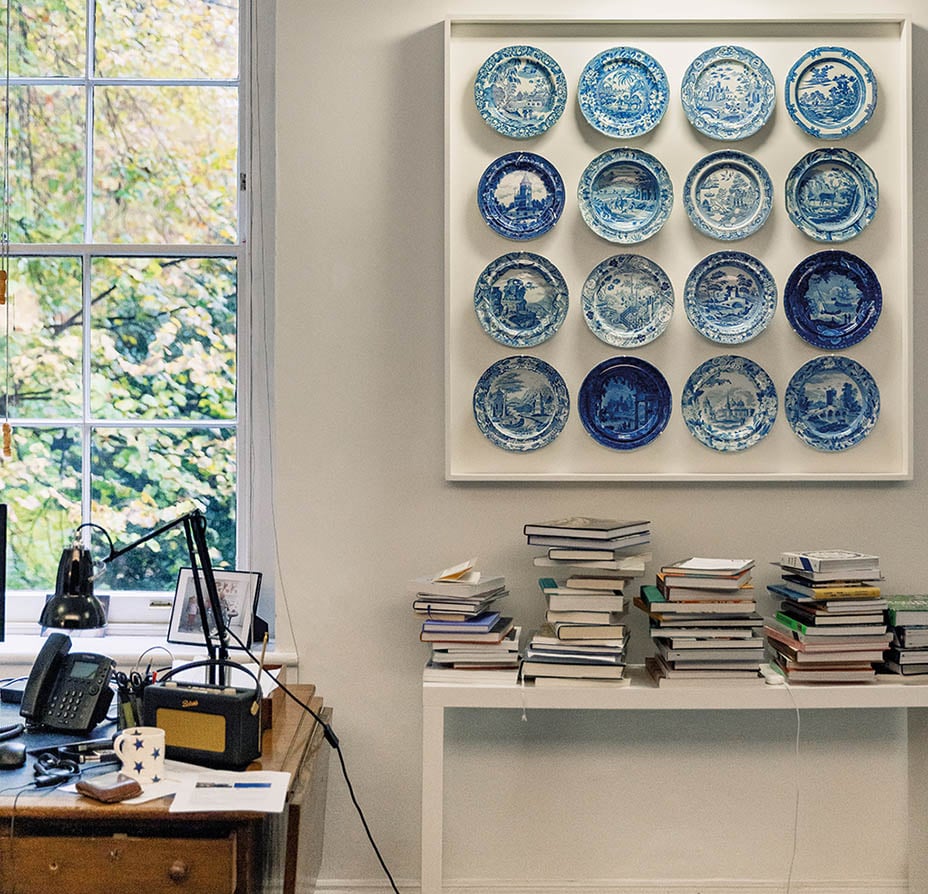
Tristram Hunt speaks to Malcolm Borthwick about the Portland Vase. Photography by David Vintiner
Please remember that the value of an investment can fall and you may not get back the amount invested. This article originally featured in Baillie Gifford’s Spring 2022 issue of Trust magazine.
There are over seven miles of galleries in the V&A, which makes it easy to get lost. So it’s just as well I’m with the museum’s director, Tristram Hunt. He leads me from his office through a maze of narrow corridors and cavernous rooms. We go past the Medieval & Renaissance galleries, where he points out a statue depicting the biblical beheading Judith and Holofernes, and through the Contemporary Glass section before finally arriving at our destination: Ceramics. And specifically, at one of Hunt’s favourite exhibits, Wedgwood’s Portland Vase.
The Portland Vase is Josiah Wedgwood’s attempt to match one of the most beautiful works of the classical world: a cut-glass vase thought to have been produced during the reign of Roman Emperor Augustus by craftsmen trained in Egypt. The 1790 version is one of the potter’s last works. Made of black jasper – a type of quartz stone – Hunt describes the vessel as “the most virtuoso depiction of Wedgwood’s technical skills, both in terms of the actual vase itself and the reliefs on it. There’s a sort of ethereal wonder to it. It’s an account of morality and death.” He jokes that he also likes it because it sits on a high shelf, making it one of the few exhibits in the gallery at the same height as his own 6 ft-plus. Surprisingly, the vase was a financial flop because it was overpriced and didn’t sell. A rare miscalculation by the entrepreneur.
Hunt’s book The Radical Potter: Josiah Wedgwood and the Transformation of Britain is a tribute to Wedgwood’s extraordinary craft and design. But it also focuses on his business acumen and marketing prowess. Hunt draws a comparison between the 18th-century potter and the 20th-century co-founder of Apple, Steve Jobs. Both were defining figures of their age, he says, with “a relentless capacity and energy to innovate. Each had an incredible reach across not just product innovation and manufacturing efficiency but marketing, the aesthetic importance of brand, advertising – there’s just the whole suite of similar skills.”

When he sees the market moving from Baroque to Rococo to Neoclassical, he just does it
In his book, Hunt cites the example of a 1765 commission from Queen Charlotte for a complete set “of tea things, with a gold ground and raised flowers upon it in green”. Other potters turned down the request fearing its complexity and expense. But Wedgwood knew the true value of taking on what was likely to be a ‘loss leader’.
After he delivered the order to St James’s the following year, he changed the name of his ‘creamware’ to ‘queensware’ and positioned himself as the Queen’s ceramics supplier. On 9 June 1776, a notice in the influential Aris Birmingham Gazette proclaimed: “Josiah Wedgwood, of Burslem, has had the honour of being appointed Potter to Her Majesty.” He took full advantage of the burgeoning media landscape and quickly placed adverts in London and in other regional papers.
It wasn’t just British royalty that Wedgwood courted and supplied. He mobilised aristocrats’ influence and patronage by giving them free products to display, not dissimilar to how modern brands use product placement in films and influencers on social media. His client list was a Who’s Who of famous names from both sides of the Atlantic, including George Washington, Benjamin Franklin, Catherine II of Russia and Marie Antoinette.
Hunt describes Wedgwood’s ability to capture the public mood: “When he sees the market moving from Baroque to Rococo to Neoclassical, he just does it. It’s not like he says, ‘I love all of these designs.’ No, no. He’s like, ‘I’m going to own this and move swiftly.’ He doesn’t get caught up in nostalgia.” Crucially, Wedgwood understood the psychology of the consumer and created mass-market luxury products (another similarity with Steve Jobs), such as vases that consumers didn’t know they needed but soon became must-haves.

Production at scale was another thing Wedgwood mastered. The production line is key, as demonstrated by modern-day entrepreneur Elon Musk, who focuses on the ‘machine behind the machine’. Hunt says the Staffordshire-born entrepreneur understood the importance of the canal system. “He made sure the canals went right past his factory because he knows the clay is going to come in and the products are going to go out, and he’s going to reduce breakages and costs. He also accelerated the division of labour, making machines of the men.” Of the 278 employees working at his factory in Etruria near Stoke-on-Trent in 1790, only five had no specific post; the others were printers, grinders, painters, scourers, throwers, turners, polishers, dippers or middle management. The roles and responsibilities of each function were detailed in Wedgwood’s Potters’ Instructions of 1780.
In his office, Hunt is animated as we discuss Wedgwood and clearly enjoys talking about design and history. The room is a miniature design museum in itself: there’s a display of Wedgwood and Spode plates and a decorative Georgian marble chimneypiece, but also a nod to the new (or newish) – a Roberts radio and Emma Bridgewater mug on his desk. The latter is a reminder of Hunt’s time as MP for Stoke-on-Trent Central from 2010 to 2017; the Emma Bridgewater factory is located in the city. It was his connection with Stoke that sparked his interest in Josiah Wedgwood. “I spent a lot of time at the Wedgwood Museum,” says Hunt. “Wedgwood is everywhere in Stoke, the statue, the street names, the memory. He is the man who, because of the combination of him and the Industrial Revolution and that moment in time, helps to create Stoke-on-Trent as almost a city.”
After Labour lost the general election in 2015 and Jeremy Corbyn was elected party leader, Hunt says he had more time on the backbenches to reflect and think about Wedgwood. First and foremost, Hunt made his name as one of Britain’s leading historians. But you can sense his political acumen – an essential quality given the multiple stakeholders he works with running Britain’s leading art and design museum. I notice he’s carefully trying to sidestep the issue of Brexit when I ask him about whether we could see another Wedgwood-type entrepreneur emerging in Britain today: “We remain very strong on innovation and creativity, but we have a lot of headwinds, to my mind, in terms of an increasingly narrow education system and, clearly, barriers with our closest trading markets.”
The only question that seems to stump Hunt is: what was the potter’s weakness? He pauses a while. “I think probably not getting into fine bone china quickly enough when Josiah Spode and the Spode market took off. And maybe succession planning [the protracted demise of the Wedgwood company is well chronicled]. But he had few weaknesses as a business leader or a manager.” Maybe the last word should go to the 19th-century prime minister William Gladstone, another admirer, speaking at the height of the Victorian industrial age that Wedgwood had helped enable: “Wedgwood was the greatest man who ever, in any age or in any country… applied himself to the important work of uniting art with industry.”
Tristram Hunt spoke in the Baillie Gifford Tent at the Wimbledon BookFest on 18 September 2021.
This article first appeared in the Spring 2022 issue of Trust, Baillie Gifford’s bi-annual investment trust magazine. To register for a free copy, delivered to your door or to your inbox please visit bailliegifford.com/trust


